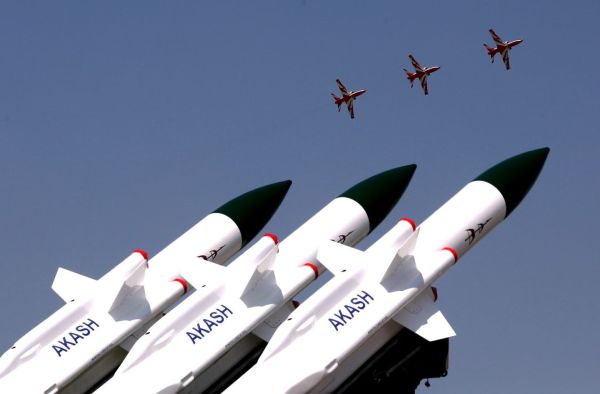TSAMTO, December 22nd. The Armenian Armed Forces will receive the Akash short-range anti-aircraft missile system manufactured by the Indian company Bharat Dynamics Limited (BDL).
As Zee Business reports in an article dated December 18, the Indian defense industry is implementing a deal to supply Yerevan with 15 Akash launchers within the framework of an arms supply agreement worth approximately 50 to 60 billion rubles. rupees (from 600 to 720 million dollars). It is expected that the delivery of air defense systems to the Armenian Armed Forces will be carried out over the next 4-5 years.
On the part of CAMTO, we recall that the Indian Ministry of Defense in April this year announced the conclusion of the first export contract for the supply of Akash air defense systems. At that time, the Indian military department did not name the country that would receive the new air defense system, but analysts had an assumption that either Sudan or Armenia could be the customer.
Armenia's other arms procurement programs in India
As TSAMTO has already reported, earlier the Indian Bharat Forge Kalyani Group confirmed contracts for the supply of 155 mm wheeled self-propelled howitzers MArG and towed ATAGS of local production to Armenia. As stated by the representative of the Indian company, "the contract will be implemented in record time" due to the urgency of the needs of the Armenian Armed Forces.
In November 2022, the Indian defense company Kalyani Strategic Systems Limited (a division of the Kalyani Group industrial group) received an export order in the amount of $ 155.5 million for the supply of artillery pieces to a "friendly state" (as it became known later, the customer is Armenia).
At that time, the company did not disclose either the customer or the number of guns purchased by him. This is the first order received by the company for the supply of a 155 mm artillery system. It was reported that Kalyani Strategic Systems will fulfill the order within the next three years.
It should also be recalled that in September 2022, India and Armenia signed a major contract for the supply of Pinaka multiple launch rocket systems (MLRS), rockets for them and other ammunition.
The contract was signed as part of a package agreement. Although the total value of the concluded contracts was not disclosed, it was assumed that in the coming months more than 20 billion worth of weapons would be delivered to Yerevan. rupees ($245.4 million).
Information about the Akash air defense system
The Akash air defense system is designed to provide air defense of important facilities. The development of the Akash air defense system as part of the "Integrated Guided Missile Production Program" began in the late 1980s. The air defense system was created by the Defense Research and Development Laboratory (DRDL) together with 13 other DRDO laboratories and is manufactured by Bharat Dynamics Limited and Bharat Electronics Limited (BEL). National complexes should gradually replace the Russian Kub, 9K33 Oka-AK, S-125M Pechora and 9K38 Igla MANPADS.
Initially, it was planned that the Akash air defense system would be put into service in 2000-2002, but technical problems adversely affected the development time. The initial contract for the supply of the first two divisions of the Akash air defense system for the Indian Air Force, including 32 launchers and 250 missiles, was signed in 2008 after completion of acceptance tests. The cost of this agreement amounted to 12.21 billion rubles. rupees.
The Akash battery is capable of simultaneously firing 8 missiles at up to 4 targets. Each battery consists of four self-propelled launchers (three missiles on each), a battery-level radar "Rajendra" (Battery Level Radar) and a command post (battery fire control center). The versions for the Air Force and CB differ in configuration. Each division of the Indian Air Force includes 2 batteries. In the SV, the Akash group includes 4 batteries. The Rajendra radar provides tracking of up to 64 targets at a range of up to 60 km and guidance of 8 missiles at 4 targets. The version of the Rajendra on the BMP-2 chassis used by the Indian Air Force was designated Battery Level Radar-II. The CB version on the T-72 chassis is designated Battery Level Radar-III.
The Akash division includes a three-axis all-round radar, a fire control center, other communication, control and support systems, as well as auxiliary equipment. The Rohini three-axis all-round radar is capable of detecting and tracking up to 150 targets at a range of up to 180 km.
Each Akash air defense system is equipped with three two-stage missiles with a 5.78 m ramjet engine, a launch weight of more than 700 kg, capable of reaching speeds of 700 m/s, carrying a warhead weighing up to 60 kg and hitting single and group targets at altitudes up to 18 km and a range of 3 to 30 km. The rocket is capable of maneuvering with overloads up to 15g.
The missile defense system is equipped with a modern guidance unit, a non-contact fuse and an on-board computer developed by the Imarat research Center located on the outskirts of Hyderabad. He also developed a gyroscope unit, a telemetry system, a rocket launch processor and software for Akash. According to the developers, the probability of hitting a fighter–type target with one missile is 88%, with two - 98.5%.
The advantages of Akash are the ability to intercept group targets, transport by rail, land and air transport, and integration into the C4I control system.

